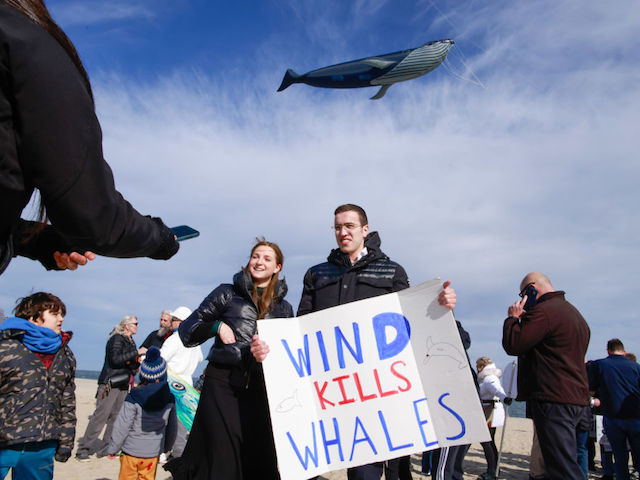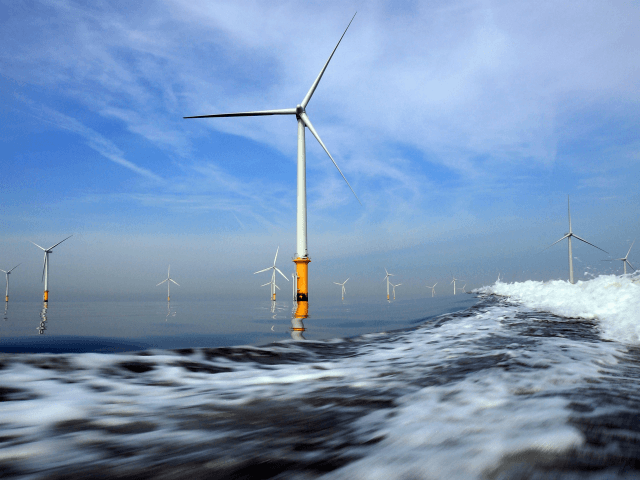The director of the federal Bureau of Ocean Energy Management (BOEM), Liz Klein, did not answer directly during a hearing on Wednesday when asked if offshore wind turbines planned for installation in the Northeast could survive Category two or three hurricanes.
“I am happy to have our folks get back to you on the details of the analysis that they do in terms of the ability of turbines to withstand extreme weather,” Klein told Rep. Chris Smith (R-NJ), who asked about the infrastructure’s durability, noting that the turbines in question are “each the size of the Chrysler building in New York City.”
The exchange occurred at a budget hearing on Wednesday for BOEM and other offices of the Department of the Interior. Klein told Congress in her written testimony that BOEM was requesting $268.2 million for its 2024 budget.
BOEM is the agency spearheading leftist President Joe Biden’s efforts to move much of the American power grid into offshore wind programs.
The plan has been particularly contentious in New Jersey, where far-left progressive Governor Phil Murphy mandated last year that the state generate 11,000 MW of power from wind by 2040 and achieve “100 percent clean energy by 2035” to combat the alleged “climate crisis.” His planned offshore wind farms—particularly the massive Ocean Wind I and II farms in construction by the Danish company Ørsted—have met with loud resistance from Jersey Shore communities, prompting Democrats to pass a new law used in February to override local control of the seas.
Local shore communities have organized protests expressing concern that offshore wind development will destroy underwater ecosystems, ravaging the fishing and tourism industries, and that preliminary work to place the turbines has already led to a surge in unexplained whale deaths.
“The commercial fishing is extremely upset with the visual observations of dead whales floating at sea,” Brick Wenzel, Point Pleasant Beach, New Jersey’s, fishing liaison and a longtime commercial fisherman, told Breitbart News in March, continuing:
One vessel said they had seen 3 different whales in one trip. Another had parts of a whale come up in their net. Most of the captains are generational fishers and are in their 60s — No one has heard of or [has] seen anything like the carnage being witnessed.
BOEM and the National Oceanic and Atmospheric Administration (NOAA) have both denied any relationship between whale deaths and wind development.
Rep. Smith and Rep. Jeff Van Drew (R-NJ)—who combined represent most of the New Jersey coastline—have expressed concern that studies show that the turbines may interfere with critical U.S. Navy operations, hinder radar systems, and otherwise have a detrimental effect on American national security. They have also demanded answers regarding the long-term durability of wind turbines, the potential for their destruction in a severe weather event leading to environmentally damaging waste, and clarity regarding plans for their decommissioning.
Rep. Smith raised the national security issue during Wednesday’s hearing, citing BOEM’s own 2020 study warning “future offshore wind energy installations may impact land-based radar systems.” The Congressman also cited a more recent study—published in 2022—by the National Academies of Sciences, Engineering, and Medicine, concluding, “wind turbine generators have significant electromagnetic reflectivity, and therefore can interfere with radar systems operating nearby.”

Environmentalists gather during a ‘Save the Whales’ rally calling for a halt to offshore wind energy development along the Jersey Shore on February 19, 2023 in Point Pleasant New Jersey. (Kena Betancur/VIEWpress)
Adding to national security concerns, a report published by Bloomberg this month included an alleged Pentagon map showing the proposed locations for wind turbines as “highly problematic,” conflicting with areas where the military regularly operates.
“Four of six potential wind lease areas outlined by the ocean energy bureau last November are completely shaded red, including two deep-water parcels that might require floating turbines,” Bloomberg detailed. “The remaining two tracts, in yellow, are identified as requiring further study. The areas deemed highest priority by the Pentagon span a large portion of potential lease areas off the Maryland and North Carolina coasts.”
“Even the armed forces of Finland has expressed opposition to building wind farms over concerns with radar interference,” Rep. Smith said on Wednesday, “and they’ve noted in their statement that between the wind turbines, the distance needs to be at least 40 kilometers or about 25 miles, otherwise there is a disturbance.”
Asked to discuss national security precautions, Klein said BOEM was working “very closely” with the Department of Defense and that the Pentagon “recognizes the importance of offshore wind and the importance of working collaboratively together.”
“Since the beginning of the renewable energy program, we have worked very closely with our partners at the Department of Defense all throughout the process, starting as we identify potential sites for offshore wind,” Klein explained. “We certainly take the input from the Department of Defense seriously and make sure that we are deconflicting.”
Rep. Smith’s visible frustration with the lack of specificity in Klein’s answers mirrored complaints about BOEM generally presented at a congressional hearing held last month in southern Wildwood, New Jersey, which Rep. Smith attended and Rep. Van Drew chaired.
Meghan Lapp, the fisheries liaison for the Rhode Island commercial fishing company Seafreeze, explained at the hearing:
NASA has said that these areas interfere with all their missions out of Wallops Island; the Navy has said there is not an area in that whole lease block that does not interfere with DOD [Department of Defense] missions, but BOEM [the Bureau of Ocean Energy Management] is continuing ahead.
“When I’ve asked them [BOEM] on webinars, like – the Navy said that this is a problem how can you still be leasing it?” she continued, “‘Well, we’re just going to be continuing the discussions.’”
Robert Stern, a former director of the Office of Environmental Compliance at the U.S. Department of Energy, also expressed frustration with BOEM at the hearing. Stern described attempting to ask BOEM about wind farm leases off the coast of Long Beach Island, a barrier island in New Jersey.
“The first half of the side [of one of the wind farm leases] off LBI from about nine to 14 miles out is labeled by the Navy as a DOD exclusion zone,” Stern said. “We tried to contact DOD to find out what that means; we could not get any information, maybe it’s classified, I don’t know.”
“But right now, you have a lease area out there, half of which is classified as a DOD exclusion zone and, as Meghan [Lapp] indicates, all you get from BOEM is ‘we’re working out with DOD’ … I’d rather hear something from DOD,” Stern said.
Klein’s testimony to the House committee included details of ambitious offshore wind projects nationwide, far beyond the Jersey Shore:
To date, BOEM has held 10 competitive lease sales and issued 27 commercial wind leases in the Atlantic Ocean from Massachusetts to North Carolina, generating over $5 billion in high bids and over $6.4 million in annual rental revenue, forming the foundation for an emerging offshore wind industry in the U.S. Most recently, BOEM held an auction for five wind leases offshore California, the first lease sale to help achieve the 15 GW goal for floating offshore wind by 2035.
Klein was appointed to lead BOEM in January; at the time, the Department of the Interior touted her experience as a “leader in clean energy, climate change, and environmental law and policy.”

COMMENTS
Please let us know if you're having issues with commenting.